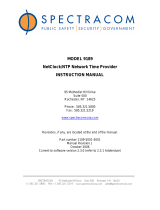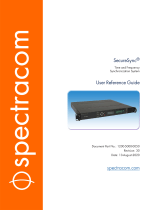Page is loading ...

XL-GPS Quick Start
This Quick Start guides you through an initial test configuration of the XL-GPS with a
standard GPS receiver, antenna, and antenna cable. If you’re using a different configuration,
or for permanent installation instructions, see the “Installation/Configuration” section in the
XL-GPS User Guide, included on the product CD.
Outline Procedure
• Position the GPS antenna with a good view of the sky and connect it to the unit.
• (optional) Connect the network port, serial port, timing inputs and outputs, as
needed.
• Connect the power cord and wait for the unit to complete its startup.
• (optional) Configure the network settings using F100 on the front panel keypad.
• (optional) Configure the time display, using F1, F2, F66, and F69 on the front panel
keypad.
• Verify GPS receiver is operating using F119, F73, and STATUS on the front panel
keypad.
Positioning the GPS Antenna
Select a site for the standard antenna supplied with the XL-GPS. The optimal site:
• Is the highest point available.
• Offers a full 360° view horizontally, to within 10° vertically of the horizon.
• Is higher than neighboring buildings/obstructions.
• Is protected from strong radio frequency (RF) and microwave transmissions.
• Is set away from RF-reflective surfaces that cause multi-path interference.
• Is set 3 ft. (1 m) away from other GPS antennas.
If positioning the antenna outdoors is difficult or inconvenient, you may be able to test the
system by placing the GPS antenna in a window that gets the noon-time sun (e.g., south-
facing for users in the northern hemisphere). East/west-facing windows with good visibility
are okay. Avoid views obstructed by nearby trees, buildings, metallic window coatings, and
window shades, all of which block GPS signals. Window-mounted GPS antennas have
reduced visibility of GPS satellites, and receive weaker GPS signals, so the unit may have
difficulty locking to, and remain locked to, GPS satellite signals.
P/N 098-00212-000 File Name 098-00212-000_RevA.pdf 05/09/2010 Page 1

Connecting the GPS Antenna
Warning: Use an antenna rated for 12 Volts. Antennas not rated for 12 V will be
damaged.
The GPS antenna cable has a TNC connector at one end, and a BNC connector at the other
end. Run and connect this cable between the TNC connector on the GPSantenna , and the
BNC connector marked "ANT" on the rear panel of the XL-GPS instrument.
Making Additional Connections
Make the following optional connections:
• Connect the network port, NET, to the LAN using with the Cat-5 network cable
(supplied). This connection can be used to manage the XL-GPS remotely by
network, or optionally, for NTP.
• Connect RS-232 null modem cable (supplied) from SERIAL I/O to the serial port on
a PC. This connection can be used to manage the XL-GPS locally, using the
command line interface.
• Make any other connections needed to J1, J2, J3, and the Expansion Module.
Consult the XL-GPS User Guide as needed.
Connecting the Power Supply
Connect the Power Supply it to a power source. The green STATUS light indicates that the
XL-GPS is receiving power.
Upon receiving power, the XL-GPS goes through its startup sequence; displaying “Booting”,
Loading”, and “Starting”. After approximately 40 seconds, the XL-GPS displays the clock
status, and user interfaces (front panel/command line) become available.
For more information, see both the Grounding, and Connecting the Power Supply sections
in the XL-GPS User Guide.
Configuring Network Settings
The following additional steps are required to make the XL-GPS operational on a network.
Make the XL-GPS operational on a network if you plan on:
• Managing the XL-GPS remotely over the network.
• Distributing timing information from the XL-GPS over the network.
Page 2 05/09/2010 File Name 098-00212-000_RevA.pdf P/N 098-00212-000

Press Result
ENTER Displays “FUNCTION”
100 Enters 100 as the function number
ENTER Displays Function 100’s first screen: “COMPANY 00-A0-69…”
ENTER Displays “IP ADDRESS…”
1-9… Enter the unit’s IP Address (e.g., 192.168.000.011
ENTER Displays “SUBNET MASK…”
1-9… Enter the Subnet Mask (e.g., 255.255.255.000)
ENTER Displays “DEFAULT GATEWAY…”
1-9… Enter the Default Gateway’s IP address (e.g., 192.168.000.001)
ENTER Displays “10 100 BASE-T – 10”
ENTER Displays “REMOTE LOCKOUT – UNLOCK” (Leave unchanged)
ENTER (5 times) Displays “SAVE CHANGES – YES”
ENTER Saves the new network parameters, and reboots the XL-GPS
Configuring the Time Display
Configure the XL-GPS to display time correctly. Use the menu-driven keypad/display
interface, to enter the functions and select the desired settings, as follows:
• F1 – Time Zone Offset: Set the number of hours difference between your time
zone and UTC. For example:
- Pacific Standard Time is UTC -08:00
- Mountain Standard Time is UTC-07:00
- Central Standard Time is UTC -06:00
- Eastern Standard Time is UTC-05:00
• F2 – 12/24-Hour Format: Select a 12 or 24-hour display format. By default, the XL-
GPS is set to the 24-hour display format (for example, 6 P.M. is displayed as 18:00).
• F66 – Daylight Saving Time (DST): If needed, set when Local time enters and
leaves DST.
- The factory settings for F66 apply to most users in the continental US: DST
begins at 2 A.M. on the second Sunday of March, and ends at 2 A.M. on the first
Sunday of November.
- DST is NOT observed in Hawaii, American Samoa, Guam, Puerto Rico, the Vir-
gin Islands, the Eastern Time Zone portion of the State of Indiana, and most of
Arizona (Navajo Indian Reservation observes DST).
P/N 098-00212-000 File Name 098-00212-000_RevA.pdf 05/09/2010 Page 3

- Throughout the European Union (EU), Summer Time begins and ends at 1 A.M.
UTC. It starts the last Sunday in March, and ends the last Sunday in October. In
the EU, all time zones change at the same moment.
• F69 – Time Mode: Select the type of time output on the front panel display, F8, F9,
and F90. The four choices are as follows:
- UTC (Coordinated Universal Time) differs from GPS Time by the addition of
leap-second corrections to compensate for variations in the earth’s rotation.
- GPS time is derived directly from the GPS constellation and doesn’t contain any
leap-second adjustments or other GPS-to-UTC corrections.
- Standard Time is UTC plus a time zone offset. For example, Pacific Standard
Time is UTC minus 8 hours.
- Local Time is UTC with a time zone adjustment and a daylight saving time
adjustment.
Verifying Antenna Installation
After completing the above steps, use the keypad/display to verify the following:
• In F119 – GPS Receiver Configuration (manual pg.101), after approximately 20
minutes of operation, check that GPS STATUS is LOCKED and GPS ANTENNA is
OK.
• In F73 – Alarm Control / Status (manual, pg. 61), check that the GPS is OK and is
ALARM ENABLED. Clear any alarm latches if present after the instrument has
locked.
• Press the STATUS key. “LOCKED GPS” should appear on the front panel display
without an asterisk. If an asterisk appears, it means that a reference source is not
available.
To troubleshoot a problematic Antenna installation, recheck the physical location of the
antenna, the cabling, and the configuration settings described in this manual.
Sales and Customer Assistance
Symmetricom's Customer Assistance Centers are a centralized resource to han-
dle all of your customer needs.
Customer Assistance Center Telephone Numbers:
l Worldwide (Main Number): 1-408-428-7907
l USA, Canada, Latin America including Caribbean, Pacific Rim including
Asia, Australia and New Zealand: 1-408-428-7907
l USA toll-free: 1-888-367-7966 (1-888-FOR-SYMM)
l Europe, Middle East & Africa: 49 700 32886435
Page 4 05/09/2010 File Name 098-00212-000_RevA.pdf P/N 098-00212-000

Technical Support can be obtained either through the Online Support area of our
website:
http://www.symmetricom.com/support/online-support/ttm-product-support/, or by
calling one of the above Customer Assistance Center numbers.
When calling the worldwide (main number), or USA-based number:
l Select Option 1 for technical support.
l Then select Option 2 for Timing, Test and Measurement Division customer
support.
Technical Support personnel are available by phone 24 hours a day, 7 days a
week through the Main Customer Assistance Center number above and from 8
a.m to 5 p.m Central European Time, weekdays, at the Europe, Middle East and
Africa number.
Customers may e-mail support requests at the following link:
http://www-
.symmetricom.com/support/techsupport/techsupport.aspx?prodtype=TTM
P/N 098-00212-000 File Name 098-00212-000_RevA.pdf 05/09/2010 Page 5
/






